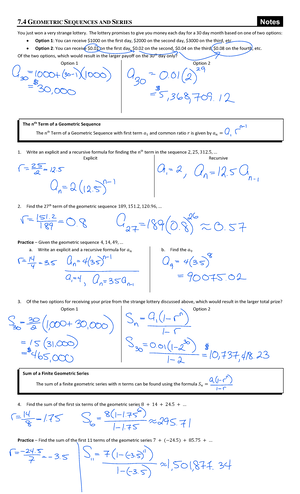- Information
- AI Chat
Was this document helpful?
10-2 Measuring Angles and Arcs
Subject: Pre-Calculus
397 Documents
Students shared 397 documents in this course
Level:
Standard
Was this document helpful?

Find the value of x.
1.
SOLUTION:
The sum of the measures of the central angles of a
circle with no interior points in common is 360.
ANSWER:
170
2.
SOLUTION:
The sum of the measures of the central angles of a
circle with no interior points in common is 360.
ANSWER:
150
arediametersof
3.
SOLUTION:
isthelongestarcconnectingthepoints
Therefore,itisamajorarc.
asminorarc
ANSWER:
4.
SOLUTION:
istheshortestarcconnectingthepoints
Therefore,itisaminorarc.
ANSWER:
5.
SOLUTION:
isadiameter.Therefore, isa
ANSWER:
6.
SOLUTION:
isaminorarc.
isaminorarc.
ANSWER:
7.
SOLUTION:
and areadjacentarcs.
measuresofthetwoarcs.
ANSWER:
8.
SOLUTION:
and areadjacentarcs.
isadiameter,
ANSWER:
9.
SOLUTION:
∠
∠
ANSWER:
.Roundtothenearest
10.
SOLUTION:
or2and
=
Therefore,thelengthof
ANSWER:
11.
SOLUTION:
ANSWER:
12.
SOLUTION:
ANSWER:
13.
SOLUTION:
circlewithnointeriorpointsincommonis360.
ANSWER:
14.
SOLUTION:
circlewithnointeriorpointsincommonis360.
ANSWER:
15.
SOLUTION:
circlewithnointeriorpointsincommonis360.
ANSWER:
16.
SOLUTION:
istheshortestarcconnectingthepoints
Therefore,itisaminorarc.
ANSWER:
17.
SOLUTION:
istheshortestarcconnectingthepoints
Therefore,itisaminorarc.
isadiameter,arc
ANSWER:
18.
SOLUTION:
isadiameter.Therefore,arc isa
ANSWER:
19.
SOLUTION:
isthelongestarcconnectingthepoints
Therefore,itisamajorarc.
ANSWER:
20.
SOLUTION:
isthelongestarcconnectingthepoints
Therefore,itisamajorarc.
ANSWER:
21.
SOLUTION:
isadiameter.Therefore, isa
ANSWER:
22.
SOLUTION:
istheshortestarcconnectingthepoints
Therefore,itisaminorarc.
ANSWER:
23.
SOLUTION:
isthelongestarcconnectingthepoints
Therefore,itisamajorarc.
∠ ∠
∠ ∠
ANSWER:
24.
“ ” “ ”
SOLUTION:
ANSWER:
25.
SOLUTION:
“”
“”
ANSWER:
26.
SOLUTION:
ANSWER:
27.
SOLUTION:
ANSWER:
28.
SOLUTION:
isadiameter.Therefore, isa
ANSWER:
29.
SOLUTION:
ANSWER:
30.
SOLUTION:
ANSWER:
31.
SOLUTION:
isadiameter.Therefore, isa
ANSWER:
32.
SOLUTION:
∠
ANSWER:
33.
SOLUTION:
ANSWER:
34.
SOLUTION:
isthesumofthemeasuresofthetwoarcs.
and arediameters,soarc
∠
Therefore,themeasureofarc
ANSWER:
35.
SOLUTION:
tofind ∠
ANSWER:
36.
SOLUTION:
∠
Therefore,thelengthofarc
ANSWER:
37.
SOLUTION:
∠
Therefore,thelengthofarc
ANSWER:
38.
SOLUTION:
Therefore,thelengthofarc
ANSWER:
39.
SOLUTION:
ANSWER:
40.
SOLUTION:
).
ANSWER:
41.
SOLUTION:
ANSWER:
42.
SOLUTION:
ANSWER:
43.
SOLUTION:
bethearclengthforthecirclewhen
Therefore,ifthediameterofthecircleisdoubled,
ANSWER:
44.
“ ”
SOLUTION:
Therefore,
where
So,
ANSWER:
45.
SOLUTION:
.
ANSWER:
46.
SOLUTION:
ANSWER:
47.
SOLUTION:
ANSWER:
∠ ∠
48.
SOLUTION:
∠ ∠
∠ ∠
ANSWER:
49.
SOLUTION:
∠ ∠
∠ ∠
∠
ANSWER:
50.
SOLUTION:
∠ ∠
∠ ∠
ANSWER:
51.
SOLUTION:
is22+22=44º
where
ANSWER:
52.
SOLUTION:
(Definitionof
(Definitionof
(Substitution)
ANSWER:
(Definitionof
(Definition
(Substitution)
53.
SOLUTION:
Constructarighttriangle
Constructaright
whichisaradiusofcircle
ANSWER:
54.
’
’
theradianmeasureofananglemeasuring90°.
SOLUTION:
a.
(arc
=
Sinceallcirclesaresimilar,thelargercircleisa
and
or
ANSWER:
or
and
55.
arecongruentsincetheircentralangleshavethe
SOLUTION:
ANSWER:
Determinewhethereach
56.
SOLUTION:
ANSWER:
57.
SOLUTION:
ANSWER:
58.
SOLUTION:
ANSWER:
59.
SOLUTION:
andformtheentirecircle,sotheirsumis360.
ANSWER:
60.
SOLUTION:
ANSWER:
61.
SOLUTION:
ANSWER:
62.
SOLUTION:
ANSWER:
63.
SOLUTION:
circlewithnointeriorpointsincommonis360.
ANSWER:
64. and
SOLUTION:
∠ ∠
∠
∠ ∠
∠ ∠
∠
ANSWER:
65. ’
SOLUTION:
Theareaofarectanglewithalengthof
.
ANSWER:
66.
SOLUTION:
ANSWER:
67.
SOLUTION:
.
ANSWER:
68.
SOLUTION:
passesthroughthecenter,soitisadiameter.
ANSWER:
69.
SOLUTION:
ANSWER:
70. – – –
SOLUTION:
)→(
1,2)→ ’
(2,1)→ ’
2)→ ’
ANSWER:
71. – – – –
SOLUTION:
)→(
→’
→’
→’
→ ’
ANSWER:
72.
isa
SOLUTION:
isa45° º º
Therefore,thecenterfielderisstanding or
ANSWER:
73.
SOLUTION:
.
6.
ANSWER:
74.
SOLUTION:
.
ANSWER:
75.
SOLUTION:
ANSWER:
–
76.
SOLUTION:
ANSWER:
–
77.
SOLUTION:
ANSWER:
–
∠
1.
SOLUTION:
ANSWER:
2.
SOLUTION:
ANSWER:
CCSS PRECISION and arediametersof
. Identify each arc as a major arc, minor arc,
or semicircle. Then find its measure.
3.
SOLUTION:
Here, isthelongestarcconnectingthepointsI
and J on Therefore,itisamajorarc.
is a major arc that shares the same endpoints
asminorarcIJ.
ANSWER:
major arc; 270
4.
SOLUTION:
Here, istheshortestarcconnectingthepointsI
and H on Therefore,itisaminorarc.
ANSWER:
minor arc; 59
5.
SOLUTION:
isadiameter.Therefore, isa
ANSWER:
6.
SOLUTION:
isaminorarc.
isaminorarc.
ANSWER:
7.
SOLUTION:
and areadjacentarcs.
measuresofthetwoarcs.
ANSWER:
8.
SOLUTION:
and areadjacentarcs.
isadiameter,
ANSWER:
9.
SOLUTION:
∠
∠
ANSWER:
.Roundtothenearest
10.
SOLUTION:
or2and
=
Therefore,thelengthof
ANSWER:
11.
SOLUTION:
ANSWER:
12.
SOLUTION:
ANSWER:
13.
SOLUTION:
circlewithnointeriorpointsincommonis360.
ANSWER:
14.
SOLUTION:
circlewithnointeriorpointsincommonis360.
ANSWER:
15.
SOLUTION:
circlewithnointeriorpointsincommonis360.
ANSWER:
16.
SOLUTION:
istheshortestarcconnectingthepoints
Therefore,itisaminorarc.
ANSWER:
17.
SOLUTION:
istheshortestarcconnectingthepoints
Therefore,itisaminorarc.
isadiameter,arc
ANSWER:
18.
SOLUTION:
isadiameter.Therefore,arc isa
ANSWER:
19.
SOLUTION:
isthelongestarcconnectingthepoints
Therefore,itisamajorarc.
ANSWER:
20.
SOLUTION:
isthelongestarcconnectingthepoints
Therefore,itisamajorarc.
ANSWER:
21.
SOLUTION:
isadiameter.Therefore, isa
ANSWER:
22.
SOLUTION:
istheshortestarcconnectingthepoints
Therefore,itisaminorarc.
ANSWER:
23.
SOLUTION:
isthelongestarcconnectingthepoints
Therefore,itisamajorarc.
∠ ∠
∠ ∠
ANSWER:
24.
“ ” “ ”
SOLUTION:
ANSWER:
25.
SOLUTION:
“”
“”
ANSWER:
26.
SOLUTION:
ANSWER:
27.
SOLUTION:
ANSWER:
28.
SOLUTION:
isadiameter.Therefore, isa
ANSWER:
29.
SOLUTION:
ANSWER:
30.
SOLUTION:
ANSWER:
31.
SOLUTION:
isadiameter.Therefore, isa
ANSWER:
32.
SOLUTION:
∠
ANSWER:
33.
SOLUTION:
ANSWER:
34.
SOLUTION:
isthesumofthemeasuresofthetwoarcs.
and arediameters,soarc
∠
Therefore,themeasureofarc
ANSWER:
35.
SOLUTION:
tofind ∠
ANSWER:
36.
SOLUTION:
∠
Therefore,thelengthofarc
ANSWER:
37.
SOLUTION:
∠
Therefore,thelengthofarc
ANSWER:
38.
SOLUTION:
Therefore,thelengthofarc
ANSWER:
39.
SOLUTION:
ANSWER:
40.
SOLUTION:
).
ANSWER:
41.
SOLUTION:
ANSWER:
42.
SOLUTION:
ANSWER:
43.
SOLUTION:
bethearclengthforthecirclewhen
Therefore,ifthediameterofthecircleisdoubled,
ANSWER:
44.
“ ”
SOLUTION:
Therefore,
where
So,
ANSWER:
45.
SOLUTION:
.
ANSWER:
46.
SOLUTION:
ANSWER:
47.
SOLUTION:
ANSWER:
∠ ∠
48.
SOLUTION:
∠ ∠
∠ ∠
ANSWER:
49.
SOLUTION:
∠ ∠
∠ ∠
∠
ANSWER:
50.
SOLUTION:
∠ ∠
∠ ∠
ANSWER:
51.
SOLUTION:
is22+22=44º
where
ANSWER:
52.
SOLUTION:
(Definitionof
(Definitionof
(Substitution)
ANSWER:
(Definitionof
(Definition
(Substitution)
53.
SOLUTION:
Constructarighttriangle
Constructaright
whichisaradiusofcircle
ANSWER:
54.
’
’
theradianmeasureofananglemeasuring90°.
SOLUTION:
a.
(arc
=
Sinceallcirclesaresimilar,thelargercircleisa
and
or
ANSWER:
or
and
55.
arecongruentsincetheircentralangleshavethe
SOLUTION:
ANSWER:
Determinewhethereach
56.
SOLUTION:
ANSWER:
57.
SOLUTION:
ANSWER:
58.
SOLUTION:
ANSWER:
59.
SOLUTION:
andformtheentirecircle,sotheirsumis360.
ANSWER:
60.
SOLUTION:
ANSWER:
61.
SOLUTION:
ANSWER:
62.
SOLUTION:
ANSWER:
63.
SOLUTION:
circlewithnointeriorpointsincommonis360.
ANSWER:
64. and
SOLUTION:
∠ ∠
∠
∠ ∠
∠ ∠
∠
ANSWER:
65. ’
SOLUTION:
Theareaofarectanglewithalengthof
.
ANSWER:
66.
SOLUTION:
ANSWER:
67.
SOLUTION:
.
ANSWER:
68.
SOLUTION:
passesthroughthecenter,soitisadiameter.
ANSWER:
69.
SOLUTION:
ANSWER:
70. – – –
SOLUTION:
)→(
1,2)→ ’
(2,1)→ ’
2)→ ’
ANSWER:
71. – – – –
SOLUTION:
)→(
→’
→’
→’
→ ’
ANSWER:
72.
isa
SOLUTION:
isa45° º º
Therefore,thecenterfielderisstanding or
ANSWER:
73.
SOLUTION:
.
6.
ANSWER:
74.
SOLUTION:
.
ANSWER:
75.
SOLUTION:
ANSWER:
–
76.
SOLUTION:
ANSWER:
–
77.
SOLUTION:
ANSWER:
–
∠
eSolutions Manual - Powered by Cognero Page 1
10-2 Measuring Angles and Arcs







